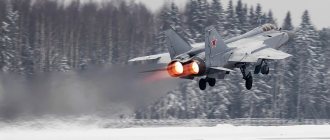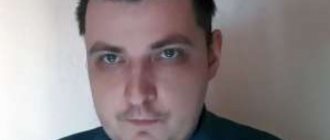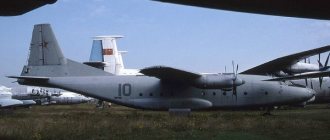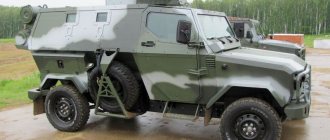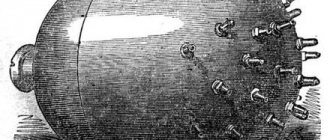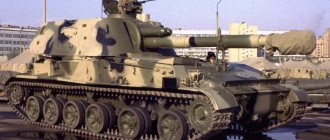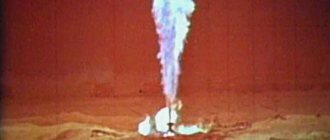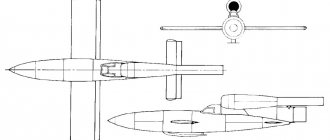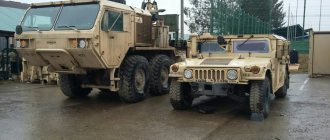What is a hydrogen bomb
Atomic Prologue
In 1913, a fiction novel by the classic science fiction writer H.G. Wells (1866-1946) “The World Set Free” appeared in England, describing the atomic bombing of Paris by the Germans in the mid-twentieth century. Wells painted a picture that reminds today's readers of Hiroshima, Nagasaki, and Chernobyl. Moreover, under the influence of the brilliant physicist Frederick Soddy, Wells predicted that the “Atomic Bomb” (his term!) was “just the forerunner of more terrible devices”... And the great classics Albert Einstein, Ernst Rutherford and Niels Bohr laughed at the speculations of this amateur.
This was the case at least until the end of the 30s, until Otto Hahn in Germany discovered the laws of fission (decay) of uranium, and in France Frederic Joliot-Curie proved the fundamental possibility of a chain reaction in uranium, i.e. the ability of uranium to explode with the release of energy millions of times greater than that produced by dynamite of the same mass. If the Germans succeeded only in the design of the implosion A-bomb (for the warhead of the V-2 rocket), without having time to produce explosives - “uranium-235”, then a secret international of talents gathered in the American Los Alamos solved the problem in a comprehensive manner. The non-trivial attempts of the Germans to approach the initiation of a thermonuclear reaction were appreciated only by specialists from the victorious countries.
The atomic race between Germany and the United States culminated in the demonstration of the destruction of two Japanese cities. Hiroshima was burned by a bomb weighing about 4.5 tons containing less than 100 kg of uranium, the explosion of which was equivalent to 12,500 tons of TNT. Nagasaki was destroyed by a plutonium bomb of similar mass, but equivalent to about 20,000 tons of TNT, and the plutonium in it was significantly less than uranium in the Hiroshima A-bomb, which was achieved by using “implosion” - an explosion inward (the foundations of its theory, by the way, were created by Guderley and other German physicists)…
Birth of the H-bomb
As soon as the Soviet Union created its own copy of the plutonium bomb (not without the help of one of its designers, the German Klaus Fuchs, a communist admitted to Los Alamos by the decision of the American atomic “czar” Robert Oppenheimer), US President Harry Truman ordered the mobilization of his scientists to create a weapon that he believed was unattainable for the Soviets—the hydrogen bomb. Moreover, such a bomb would be capable of exploding the equivalent of a million tons of TNT. Edward Teller had long and fanatically cherished plans to create such a weapon. Ever since the Italian Nobel physicist Enrico Fermi suggested this idea to Teller in 1942 - so far in an abstract form.
In Germany, the idea of the H-bomb was approached back in 1938 by the son of the Secretary of State of the Hitler government, Karl Friedrich von Weizsäcker (whose younger brother, by the way, became the president of Germany after the war), who earned scientific fame (he was denied the Nobel Prize) by creating the foundations of the modern theory of star combustion “ solar" class.
At first glance, the idea of an H-bomb may seem like an almost banal reproduction of the natural stellar process of burning hydrogen into helium, releasing energy many times greater than the decay of uranium or plutonium. It is not for nothing that the English astrophysicist Arthur Eddington, who guessed (together with the Frenchman Jean Perrin, but independently) in 1920 that it was thermonuclear reactions that caused the radiation of most stars, repeatedly warned about the possibility of creating thermonuclear weapons.
In short, using an atomic bomb as a “match head”, and deuterium as a “stick” set on fire by the atomic head, we make a “super” bomb, Truman and Teller persuaded himself. And Truman confidently announced to the whole world about the upcoming creation of the H-bomb in the United States, having signed the necessary directives and believing that after Fuchs there were and could not be Kremlin informants in the US atomic lair. Truman's declaration was made on January 31, 1950, and a few weeks later a young Los Alamos mathematician, Polish emigrant Stanislaw Ulam, playing with a slide rule, ingeniously simply proved that Teller's “super” was ineffective.
Before Teller had time to think about how to kick such a saboteur out of work, the largest theorists at Los Alamos (if not the whole world), Enrico Fermi and John von Neumann, reasonably confirmed Ulam’s calculations. And the most secret secret of American nuclear scientists suddenly became precisely the inoperability of this N-bomb project. In the USSR, Yakov Zeldovich tried in vain to implement a similar project, for the time being unaware of Stan Ulam’s findings. And the same Ulam saved the H-bomb program: by the beginning of the spring of 1951, he invented the principle of the design of modern thermonuclear weapons: thermonuclear explosives need and can be compressed implosionally (by exploding inward) to a super-dense state before ignition.
Teller, who was taken aback, was able to adapt to Ulam’s ideas and even - not without the help of the junior talents of his team - improved practically effective means of implementing implosion supercompression. Then he tried to trivialize Ulam’s idea, explaining it through a principle long known to every motorist: they say, in a thermonuclear engine, the fuel must first be compressed and then ignited - like Diesel! But in diesel engines, the density of the fuel mixture increases only several times (and not hundreds of times), and this is done without radiating plasma and without implosion (they also say “cumulation”), the creation of a theory and implementation of which is the lot of Nobel talents level.
Only recently it was declassified to what density it was necessary to compress the explosive - liquid deuterium of the first prototype of the Los Alamos H-bomb: approximately to the same density that is achieved in the center of the Sun - about 100 grams per cubic centimeter, and at a pressure of about a thousand billion atmospheres! Let me remind you that the initial density of liquid deuterium is five times less than water.
Metaphors are metaphors, but creating at least for a moment (billionths of a second) stellar matter on Earth is not some kind of diesel... In essence, how would the problem of creating a version of a time machine be solved, since deuterium in such a super-dense state is the plot of the beginning "Big Bang" of the Universe.
American "Mike" and others
It is to Ulam that America owes the victory in the round of the nuclear arms race, and specifically the creation of the 82-ton thermonuclear monster “Mike” measuring 203x617 cm, detonated on November 1, 1952. Mike's filling, about 500 liters (100 kg) of heavy hydrogen, was momentarily compressed to a liter volume, i.e. The density of hydrogen reached five times the density of gold.
Mike's explosion was equivalent to 10,400 kilotons of TNT. In addition to intense radiation and a powerful shock wave, “Mike” caused the evaporation of 80 million tons of soil. Mike's crater was half a mile deep and two miles in diameter. The mushroom cloud of this explosion, about 13 km across, rose to a height of 45 km. Irradiation of the bomb's uranium layers with thermonuclear combustion products produced new transuranium elements, which gave the British a reason to come up with the key ideas for creating their own H-bomb without direct US help.
Our “Kurchatovites” failed to detect these curious atmospheric emissions... Sakharov’s bomb turned out to be not entirely complete - compact, but relatively weak. True, Sakharov got rid of the impractical liquid (cryogenic, at a temperature of minus 250 degrees!) deuterium, using powdered dry explosive “lithium deutrite”. The late Los Alamos scientists reacted to this with a bit of envy: “Instead of a huge American cow with a bucket of raw milk, the Russians use a package of powdered milk.” Still, Sakharov missed the main principle - super-density, and the efficiency of his bomb was too low.
Sakharov managed to overtake the Americans (and forever!) in explosion energy in 1961, when on October 30, an explosion of his “device” was heard over Novaya Zemlya - a 20-ton bomb, nicknamed “Kuzka’s Mother”, equivalent to 100 megatons, although purposefully reduced to 60 megatons In this bomb, dropped from the strategic Tu-95, the mentioned Ulam principle was already at work, information about which could have been conveyed from Los Alamos to Moscow by Edward Teller’s colleague, the Soviet defector Georgy Gamow, with whom Kremlin agents maintained contact through his wife.
The “best” in the United States was a 15-megaton explosion on February 28, 1954, although they later had bombs designed for 24 megatons. The Americans equipped the notorious B-52 strategic bombers with them, which for years played the main role of the “big stick” along with the Polaris and Trident submarines, as well as MiniMX missiles.
The Kremlin celebrated: unlike the vulnerable B-52 with their 24-megaton bombs, our nuclear forces began to arm themselves with non-interceptable Chelomeev UR-500 missiles (with Valentin Petrovich Glushko engines) - 550-ton prototypes of the famous 700-ton Protons, until now since very competitive space launch vehicles.
Fortunately for humanity, both our 100-megaton warheads for Chelomey’s intercontinental missiles and the American 24-megaton bombs for Boeing strategic bombers have long been withdrawn from service as a deliberately barbaric weapon of genocide...
Sakharov himself (unlike Teller) became the Dove of Peace, and the nuclear arms race continued not along the lines of gigantomania. The US/USSR parity was defended by younger talents, among whom in the USSR were Babaev, Zababakhin, Avrorin, Feoktistov, Trutnev...
Meanwhile, China (with the help of Moscow), Israel without conducting its own nuclear tests (with the help of the United States), not to mention Britain and France, have also mastered more or less modern thermonuclear technology. India is persistently and inexorably approaching this... What awaits us other than the spread of these weapons around the world - so far more suitable for intimidation than for real battles?
Hydrogen Technology Trends
Current trends indicate a movement towards greater practicality of nuclear weapons. Already at the height of the barbaric bombing of Yugoslavia, the United States was seriously studying scenarios for “targeted” nuclear strikes against formations of the Yugoslav army, whose combat capability seriously frightened NATO. Viktor Chernomyrdin's mission freed the United States from these worries.
The tasks of recent times - in Afghanistan and Iraq - could be solved in a targeted manner, i.e. small (equivalent) nuclear strikes. For example, a nuclear warhead with an equivalent weight of up to 10 kilotons, packaged in a particularly strong casing of a specific shape, is capable of penetrating almost any soil tens of meters - at least under a heavy-duty bunker, where it explodes, creating a cavern into which the bunker will fall, and collapse on its roof. hundreds of tons of rock.
A more sophisticated scenario is the creation of compact nuclear weapons operating on the principle of a directed (cumulative) nuclear explosion. The same Ulam openly published such an idea in the late 1950s, then it was developed by his student Taylor. When implemented, a relatively lightweight munition can have a local impact on the target, similar to non-directional munitions of much greater total power.
But the future promises something even more interesting and “romantic”: the so-called controlled inertial thermonuclear reaction - a million-fold miniaturization of hydrogen bombs to the size of a thimble - for the use of thermonuclear microexplosions. A hydrogen microbomb is thousands of times cleaner than a “normal” one. There are no fissile materials in its design, and the explosive will be a mixture of deuterium with the light isotope helium-3 (instead of radioactive tritium). Then the "ash" is mostly ordinary hydrogen and helium-4.
This is a prospect not only for industrial energy, but also for other areas, incl. (primarily?) for ultra-high-speed rocket ships Earth-Mars-Earth with astronauts on board. At the US Livermore Laboratory, these ideas have been developed since 1961 by physicists such as John Nuckolls, Lovell Wood, Roderick Hyde and Charles Orth, and were seriously supported by Teller himself. In our country this direction was recognized and approved by A.D. Sakharov and V.P. Glushko. The author of this article has devoted years to his microexplosion scenario for aerospace systems. But that is another story.
"Product 602"
The meaning of this typically Russian idiom was completely incomprehensible to the Western public. This made the threat, accompanied by the tapping of Khrushchev’s shoe on the podium, take on an ominous character. He, of course, did not mean a small harmful bug, a cereal destroyer, or his mother, but something more real. Nikita Sergeevich explained this during the days of the Cuban Missile Crisis, when the world was one step away from nuclear war: “We will bury you, the imperialists!” How he intended to do this became clear in his statement at the XXII Congress of the CPSU. On that day, a thermonuclear charge was detonated on Novaya Zemlya, 10,000 times more powerful than the atomic bomb dropped on Hiroshima. “Product 602,” as the thermonuclear bomb was encrypted, could have wiped out New York and its surrounding cities in the blink of an eye. With the light hand of Nikita Khrushchev, the bomb was given the name “Kuzka’s Mother”, although the creators called it “Ivan”. Once I had the opportunity to meet with a nuclear tester, a veteran of special risk units, Colonel N.G. Kostetsky. “Work on the creation of “product 602,” he said, “began in 1954 at the nuclear power plant. Although Snezhinsk, where the nuclear center is located, had nothing in common with Chelyabinsk. You will not find Snezhinsk on any map of the world. It is hidden from the world by a dense forest, deep secrecy, barbed wire, observation towers and vigilant checkpoints at the entrance. Nuclear scientists and their families live there, having signed a non-disclosure agreement.
A nuclear shield was forged in a secret forge
Nikolai Georgievich turned out to be a very interesting interlocutor. He spent half his life at testing sites. “By the summer of 1961, “product 602” was ready,” he continued the story. - It looks like an ordinary bomb. More than a dozen of these were “made” here, although this one was somewhat reminiscent of a shark with an elongated shiny body, tail and dimensions of 12 meters in length. Its charge is 100 megatons. Scientists were seriously afraid that our planet might fly off the rails, that is, from orbit. But Khrushchev insisted: “It will be necessary, you will make a bomb of a thousand megatons. Then we will definitely bury the imperialists!” Nikita Sergeevich did not think that there would be no one left, even us. But he was in a hurry with the “hundredth”. I couldn’t wait to announce its testing at the party congress. The question arose about the location of the Kuzkina Mother explosion. There was no particular controversy - of course, Novaya Zemlya! The area is 82,600 square kilometers, the entire archipelago is a continuous testing ground. But in the affected area with a radius of 1000 kilometers were Vorkuta, Dudinka, and most importantly, Norilsk, with its copper-nickel plant. And the port of Dikson is generally 500 kilometers away. Although it was a pity, they decided to make the charge half - replacing 2 tons of uranium-238 with an equal amount of lead. The power of the bomb decreased, but not to 50, but to 57 megatons. And then the day “X” came. Early in the morning, before our eyes, “mama” was taken out on a platform by an army tractor and, with great caution, delivered to the airfield. The Tu-95M strategic bomber was already waiting for her there. The bomb hatches had to be left open - the bomb could barely fit. From the ground, when the plane took off, it seemed as if a giant hawk was carrying a huge egg in its talons...
Kostetsky's peaceful charges
Nikolai Georgievich was modest in his story. He was not aloof from the trials; it was not for nothing that he became a colonel. But he didn’t talk about it, he turned the conversation to peaceful topics. I found out then that Nikolai Georgievich became the laureate of the State Prize for the creation of a new design of peaceful nuclear charges. Their power was going to be used in the construction of a main canal through which the waters of the northern rivers were supposed to feed the shallowing Caspian Sea. However, the project was not implemented. Money was urgently needed for the construction of the BAM. And yet Kostecki’s charges served the country. An underground nuclear explosion crushed a giant ore body in Apatity. So much ore was mined that it was exported within two years. In the Urals, after the detonation of a nuclear charge, a huge container formed in a mountain. where millions of cubic meters of gas were pumped. In Uzbekistan, a gas fountain that burned for about two years was silenced with a nuclear charge. Kostetsky's charges to this day give a second life to old oil wells, where a lot of black gold has accumulated.
